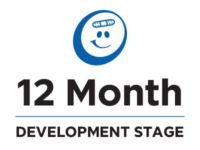Downloadable Files
DEVELOPMENT
Daily Activities
- Usually follows a definite daily pattern
- Opens cabinets, pulls tablecloths
- Usually examines an object before putting into mouth
- Likes to feed self
Motor Skills
- Usually walks with assistance; may walk without assistance
- Crawls rapidly
- Stands alone
- Seats self on floor
Language
- Expresses complete thought with single syllable
- Shows definite understanding of a few simple words
- Utters a few words (mama, dada, ball, dog)
- Loves rhythms and rhymes
Emotional/Behavioral
- Shows more negativism (may resist naps, refuse certain foods, throw occasional tantrums)
- Continues to prefer people to toys
- Has developed a deep attachment to a few familiar people
- Loves to make parents laugh
- Shows somewhat less stranger anxiety
- May give up something on request
- Displays a sense of humor
FEEDING
Now that your child is 1 year old, you may start using whole milk instead of formula or breast milk. Babies need whole milk (instead of low-fat or skim) until they are 2 years old. Some babies have harder bowel movements at first with whole milk. Now is also the time to wean completely off the bottle and switch to the cup.
Table foods are best now. Baby food is usually not needed anymore. No junk food! Most babies have 1 to 2 snacks each day. Cheese, fruit, and vegetables are all good snacks. Serve milk at all meals.
Babies do not grow as fast during the second year of life. Your baby may not eat as much as he used to. Trust your baby’s appetite.
SAFETY TIPS
- Avoid Choking and Suffocation
- Avoid foods on which a child might choke easily (candy, hot dogs, popcorn, peanuts)
- Cut food into small pieces, about half the width of a pencil
- Store toys in a chest without a dropping lid
- Practice a fire escape plan
- Check your smoke detector. Replace the batteries if necessary
- Put plastic covers in unused electrical outlets
- Keep hot appliances and cords out of reach
- Keep all electrical appliances out of the bathroom
- Don’t cook with your child at your feet
- Use the back burners on the stove with the pan handles out of reach
- Turn you water heater down to 120 degrees F (50 degrees C)
- Never leave an infant or toddler in a bathtub alone
- Continuously watch your child around any water, including toilets and buckets.
- Keep toilet seats down and store buckets upside down.
- Make sure windows are closed or have screens that cannot be pushed out
- Don’t underestimate your child’s ability to climb
- Keep all medicines, vitamins, cleaning supplies, and gardening chemicals locked away or disposed of safely
- Install safety latches on cabinets
- Place the Poison Control number close to phone (1-800-222-1222)
NO WORRIES
Each child is unique. It is therefore difficult to describe exactly what should be expected at each stage of a child’s development. While certain behaviors and physical milestones tend to occur at certain ages, a wide spectrum of growth and behavior for each age is normal. These guidelines are offered as a way of showing a general progression through the developmental stages rather than as fixed requirements for normal development at specific ages. It is perfectly natural for a child to attain some milestones earlier and other milestones later than the general trend. Keep this in mind as you review these milestones.






